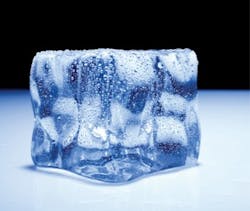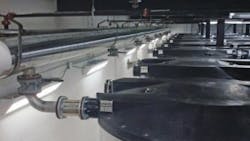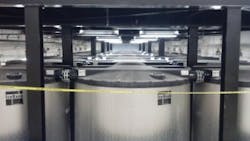Reducing Daytime Energy Costs With Nighttime Activity
As demands for electric power continue to increase during the day, especially in the summer months when air conditioners are sucking up massive quantities of energy, utilities—which are unable to generate enough power to meet these excessive loads—are forced to purchase power from “peaking plants,” which are generally gas-fired plants that can be brought to full power relatively quickly. However, the convenience of these peaking plants is not without a cost, usually a hefty one. Of course, the local utilities must pass these costs on to their customers.
As a result, utilities and others involved in the energy industry have been seeking ways to reduce the demand for peak energy. One of the most widespread, popular, and successful strategies involves demand-response programs. With such programs, utilities and their customers (most commonly commercial and industrial, but also in some cases residential) agree that, when peak demand is at hand, the utility will have the authority to remotely shut down or at least curtail certain pieces of equipment at customer locations in order to reduce demand. In some cases, customers with adequate onsite IT options are able to receive signals from their utilities and arrange to shut down or curtail their own equipment.
However, while customers and utilities that participate in demand-response programs are able to agree on which pieces of equipment can be conveniently shut down or curtailed, when, and for how long, there are still some consequences that not everyone considers.
For example, if you raise the temperature in a building by a couple of degrees by cutting back on air conditioning, this will affect the comfort level of the employees, which can therefore negatively impact productivity. Reducing light levels can also have a negative impact on productivity, as well as on work quality, since more errors are likely to occur when lighting levels are not optimum enough for people to see their work.
For example, a report published in 2010 by CareerBuilder, based on a survey of 4,285 US workers, found that 22% of respondents claimed that a workplace that was too hot made it difficult to concentrate, and 11% made the same claim about temperatures that were too cold.
So what is the ideal temperature range? A study published in 2006 by the Environmental Energy Technologies Division of the Lawrence Berkeley National Laboratory found that workplace performance is most effective when temperatures are between 69.8°F and 71.6°F, with the highest productivity being seen at around 71.6°F.
This means that if you are involved in a demand-response program to save dollars on your utility bill, especially a program that involves upping the indoor temperatures a few degrees during the summer by curtailing air conditioning, you are likely to lose many more dollars in lost productivity and quality.
There is an alternative: a solution that allows you to reduce your utility bill, while at the same time maintaining productivity and quality by allowing air-conditioning temperatures to remain the same as they always have been. The solution involves some nighttime activity.
“The only source of energy that has not gone up in price in the last 40 years is off-peak electricity,” says Mark MacCracken, CEO of CALMAC, which manufactures energy storage equipment. “In fact, while peak prices have increased, off-peak electricity prices have actually decreased a little bit. The reason is that the utilities have all of this excess capacity available, and no one is taking it; so it is a supply and demand issue.”
In addition, according to MacCracken, with the increased availability of renewable energy, such as wind which blows the most at night, and given the fact that there is currently no way to store energy produced on the grid, the wholesale price of electricity at night has been driven to zero in some cases, such as in West Texas, where wind farms are plentiful. “So, as we add more wind, the price of electricity at night will continue to remain extremely low, while the price during the day will continue to remain high,” he says.
The question then becomes: If energy is so cheap during the night and so expensive during the day, is there any way we can purchase more electricity at night in such a way that it allows us to purchase less during the day? There is indeed. It is called thermal storage—in the form of ice.
“If there was a gas station in your neighborhood selling gasoline for 99 cents a gallon at night and $2.99 during the day, you would buy it at night,” says MacCracken. “It would be ludicrous to buy it during the day. However, this is what is done every single day in office buildings, given that electric rates are higher during the day than they are at night.”
Thermal storage is an effective alternative to demand-response programs, because it allows building owners to maintain temperatures and lighting for employees that are comfortable enough to allow them to remain productive, which, as detailed earlier, may be more cost-effective than saving money by being in a demand-response program.
As MacCracken sees it, the pulling together of generation and storage makes complete sense. “Historically, the electric grid was up to about 70% load factor, meaning that all of the equipment was being used 70% of the time during the year,” he says. “This was a relatively high load factor. However, with the advent of air conditioning, the load factor has been going down, and we are now below 50%, meaning that we have about twice as much generation, transmission, and distribution as we need in this country if we use electricity at a level rate day and night.” That is, while equipment runs at high levels during the day to meet the demands of air conditioning, it does not run at high levels during the night, thus reducing the load factor percent.
As such, if a building is able to utilize generation at a higher percentage, it makes everything more cost-effective. This is what thermal storage does for a cogeneration system. Cogeneration has the benefit of providing heat onsite, so you can utilize the heat for heating and cooling, and then utilize the generation capacity at nighttime to create storage, so you don’t need those electrons during the day, when power needs are at their peak.
“It takes about 150 to 300 pounds of ice to cool a person in a building per day,” says MacCracken. “If you can create this cooling capacity at night by making ice when electric rates are low, it reduces the costs associated with having to create the cooling during the day when rates may be twice or even three times as high.”
Ice storage system components
The concept of “ice storage air conditioning” involves using ice for thermal energy storage. Given that air-conditioning systems, especially in large commercial buildings, are the larger contributors to peak electric demand, the technology is commonly used in campuswide air-conditioning or chilled water systems in large buildings. In this application, a standard chiller runs at night (when electric prices are low) to produce ice piles. Then, during the day, water circulates through the ice piles to produce chilled water that would normally be created during the daytime by the chiller’s daytime output. So, at night, the chillers produce ice for storage, and then chill water during the day for use in the air-conditioning system. The water circulating through the melting ice augments this production.
“In the future, I see storage growing in a big way,” says MacCracken. “On the utility side, utilities will begin to get more involved in storage through compressed air, batteries, and flywheels. On the building side, there will be an increase in the use of thermal storage. The practice of increasing demand during the day and using almost nothing at night simply does not make sense anymore.”
Thermal Storage in Action
The State of Michigan Secondary Complex (Dimondale, MI) is a 13-building campus that includes the state’s police academy and police post, test and research labs, office space, warehouses, vehicle maintenance service garages, and other facilities.
Its original energy center was constructed in 1975 and featured electric chillers and gas-fired boilers. Since that time, though, buildings in the Complex have been renovated and additions have been made, which have resulted in a major impact on the efficiency levels of the heating and cooling operations.
When it became clear that the energy being consumed for HVAC activities were becoming a significant part of the operating budget, the state realized the importance of getting involved in energy efficiency, not just at the Secondary Complex, but statewide. In 2008, the State passed Public Act 295, part of which included a requirement for the reduction of state government grid-based energy purchases of 25% by 2015, compared to a 2002 baseline. One strategy was to seek reductions in peak demand. The other was to begin to rely more on onsite energy generation.
As such, as a way to rely more on onsite energy generation, the decision was made to implement cogeneration and energy storage at the Secondary Complex. In 2012, the Complex installed two 1.2-MW natural gas-fired turbine generators to produce steam and electricity for central heating and cooling operations, thus reducing the amount of power required from the power grid. Steam generated from the turbines was dedicated to heating the 2 million square feet of buildings at the Complex, and was also utilized by two absorption chillers to create chilled water for cooling operations.
Another Campus Solution: Washtenaw Community College
GEM Energy has completed Washtenaw Community College’s (WCC) first combined cooling, heat, and power (CCHP) system, which is in place at the college’s United Association (UA) Great Lakes Regional Training Center. GEM also donated another microturbine to train future energy professionals in the training center.
The CCHP system will generate 130 kW of electricity, 800,000 BTU per hour of hot water, and 50 tons of chilled water for the training center. As a result, the college and training center will avoid nearly $60,000 a year in utility costs.
The natural gas-powered system, designed and built by GEM Energy, includes two Capstone C65 microturbines, an absorption chiller, and a new cooling tower. A FlexSet Distributed Generation monitoring system displays real-time operating results. The turbines generate electricity and hot water onsite for use in campus buildings. The excess heat is then captured and used to help with air conditioning of the buildings. “The main component in the CCHP system is the Capstone natural gas turbines,” says Greg Steenrod, vice president, GEM Energy. “The turbines operate year around and generate electricity for the campus.”
L-R: Shane Spring, GEM Energy project engineer; Glenn Powers, GEM Energy design engineer; and Jeremy Damstra, GEM Energy energy solutions engineer, with the CHP system
For a CCHP system to operate, the hot exhaust must be utilized. To capitalize on this in both the heating and cooling seasons, an integrated heat exchanger and a hot water absorption chiller are used. “During the heating season, the integrated heat exchanger, through the circulation of water, captures exhaust heat and circulates hot water through the facility. In the cooling season, this same hot water is directed to an absorption chiller and cooling tower to create and provide chilled water to the facility,” says Steenrod.
The CCHP system operates in addition to the existing heating and cooling system at the college. “The system was engineered to fulfill the base load requirements of the building,” says Steenrod. “When operating this way, the system is optimized for both energy use and dollar savings.”
Were there any challenges along the way? “A primary intention of this system is to demonstrate the system operation and maintenance to students,” he says. “The location needed to support the weight of the cooling tower and platform, and also allow students to gather, two requirements which made complex engineering necessary.”
A location was selected that offered students safe access via an existing staircase. Then, with assistance from structural engineers, a platform was built to withstand the weight of 20 students. The total cost of the project was around $860,000. The UA paid for 75%. With WCC’s 25% investment ($215,000), the college should be able to achieve an ROI after 4 years, and the system is expected to last for between 15 and 20 years.
However, since that time, the cooling load requirement within the Complex began to increase due to the addition of new buildings, technology, and equipment. As a result, the Complex realized that it needed a solution that could seamlessly integrate into its existing energy center, reduce peak demand, and create redundancy within the system.
The State already had thermal storage technology, including CALMAC tanks, at the Saginaw State Office Building and realized that this solution, which provided ice-based thermal energy storage, was creating savings. As a result, it selected a similar solution at the Complex. As such, the Complex would be able to benefit from both of the state’s strategies to reduce energy costs: more onsite generation, and reduction in peak demand requirements.
In 2014, the Complex installed one 900-ton centrifugal, dual-mode, water-cooled chiller provided by Nelson Trane, plus Trane Tracer chiller controls. The chiller operates using energy from the grid and is paired with CALMAC’s IceBank energy storage tanks, which can store 1 MW of energy, which is equivalent to 8,748 ton-hours of cooling. Two levels of energy storage tanks were installed in a storage area at the Complex.
“When we investigated our options to add some redundant cooling as well as some additional capacity, we opted for the thermal storage solution,” says Scott Davis, facility supervisor of Zone 6 at the Complex. “One reason is that the State is a leader in implementing new processes and technologies like this. Another reason is that it offered a payback, rather than just the cost associated with installing new equipment.”
During the planning and installation process, the only challenge that developed related to the placement of the tanks. “Systems such as these are typically buried outside and underground, which we did not want to do,” says Davis. “We were fortunate enough to find some excess warehouse space, and that has worked out well. It is a little further from the operations floor than we would have liked, but it was still close enough that piping and pumps were unaffected.”
“Our tanks don’t create the cooling,” says MacCracken. “They just store the cooling that is generated by the chillers. Thirty years ago we realized that, if you were going to be installing thermal storage in a building, there needed to be a standard chiller and the option to modify it in terms of how it will be run, when it will be run, and what it will be cooling.”
That is, instead of creating cooled water and circulating it through the building during the day, antifreeze is put into the water, and the chiller is operated at night. This liquid then gets diverted over to the tanks, which store the cooling. “We based our design on a standard, commercially available chiller, so there are only minor differences between a system that uses our storage tanks and a standard water chiller system,” he says.
The ice storage system is designed to provide redundancy to the cogeneration plant. When steam is available for cooling, it must be utilized, since this form of energy cannot be stored effectively. However, if cooling demand exceeds the capacity of the steam-driven chillers, CALMAC’s IceBank tanks provide the additional cooling requirements.
“CALMAC’s energy storage technology has allows us to make our system extremely flexible in order to meet changing heating and cooling needs,” says Davis. “Utilizing cheaper nighttime energy has always been an attractive opportunity, especially for a large complex like ours. Now it is a reality. In fact, the major benefit is the ability to shift our energy load to an off-peak timeframe, which allows us to lower our energy costs. We also like the flexibility of it. We can increase or decrease output easily, with valve controls.”
That is, the incorporation of ice-based thermal energy storage allows the Complex to create cooling hours during nighttime off-peak hours, when electricity prices are at their lowest. By storing and using cooling as needed, the Complex can avoid expensive peak demand hours. Based on historical data, the addition of this storage is expected to save an estimated $12,000 per month in energy costs for the Complex.
In addition, as mentioned, the system provides a lot of flexibility. The Complex is able to cool the facility in a number of ways—just using ice, using the absorption chillers that are powered by steam, using the three centrifugal chillers, using free cooling heat exchangers, or using any combination of these. Currently, the Complex’s energy plant relies heavily on the cogeneration technology, which powers the absorption chillers, with the ice-based energy storage assisting as needed. The ability to use the cogeneration and natural gas to remove some of the Complex’s load off the grid is helping to meet the State’s goal to reduce grid-based energy purchases.
“Ice-based energy storage has allowed the State of Michigan to separate when energy is purchased from when it is needed,” says MacCracken. “This decoupling, in combination with cogeneration, has greatly reduced its energy using during peak demand hours.”
CALMAC was involved in a similar project at the University of Arizona in Tucson, which has a loop of 28,000 tons. The reason that the University got involved in storage is that it was using waste heat from its 14-MW turbines to power the university medical center’s needs for heating and cooling, laundry, and sterilization. However, at night in the fall, winter, and spring, the electric loads were going down so low at night because of the lower demand for cooling that the university couldn’t keep its own generators on.
“As a result, they were having to activate 100,000-pound steam boilers in order to satisfy the needs of the hospital,” says MacCracken. An engineer who studied the problem notes: “You always need cooling here. Why not put storage in, make ice at night, and use it for cooling during the day. Making the ice at night will load the generators back up, which will continue to provide the waste heat for the hospital, so you can turn off the 100,000-pound steam boilers.”
“The University has three phases of adding storage to its loop, with 14 megawatts of generation,” says MacCracken.
William Atkinson specializes in topics related to utilities and infrastructure.





